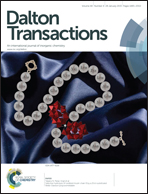A sterically stabilized FeI–FeI semi-rotated conformation of [FeFe] hydrogenase subsite model†
Abstract
The [FeFe] hydrogenase is a highly sophisticated enzyme for the synthesis of hydrogen via a biological route. The rotated state of the H-cluster in the [FeIFeI] form was found to be an indispensable criteria for an effective catalysis. Mimicking the specific rotated geometry of the [FeFe] hydrogenase active site is highly challenging as no protein stabilization is present in model compounds. In order to simulate the sterically demanding environment of the nature's active site, the sterically crowded meso-bis(benzylthio)diphenylsilane (2) was utilized as dithiolate linker in an [2Fe2S] model complex. The reaction of the obtained hexacarbonyl complex 3 with 1,2-bis(dimethylphosphino)ethane (dmpe) results three different products depending on the amount of dmpe used in this reaction: [{Fe2(CO)5{μ-(SCHPh)2SiPh2}}2(μ-dmpe)] (4), [Fe2(CO)5(κ2-dmpe){μ-(SCHPh)2SiPh2}] (5) and [Fe2(CO)5(μ-dmpe){μ-(SCHPh)2SiPh2}] (6). Interestingly, the molecular structure of compound 5 shows a [FeFe] subsite comprising a semi-rotated conformation, which was fully characterized as well as the other isomers 4 and 6 by elemental analysis, IR and NMR spectroscopy, X-ray diffraction analysis (XRD) and DFT calculations. The herein reported model complex is the first example so far reported for [FeIFeI] hydrogenase model complex showing a semi-rotated geometry without the need of stabilization via agostic interactions (Fe⋯H–C).
![Graphical abstract: A sterically stabilized FeI–FeI semi-rotated conformation of [FeFe] hydrogenase subsite model](/en/Image/Get?imageInfo.ImageType=GA&imageInfo.ImageIdentifier.ManuscriptID=C4DT03223C&imageInfo.ImageIdentifier.Year=2015)

 Please wait while we load your content...
Please wait while we load your content...